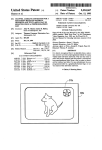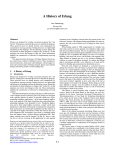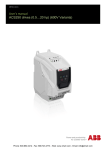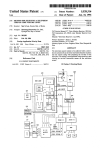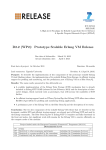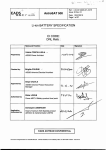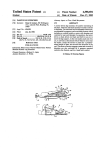Download a 7 :1` 2% <
Transcript
. US005440339A States Patent [19] [11] Patent Number: Harrison et al. [45] Date of Patent: [54] SYSTEM AND METHOD FOR TESTING AverKey Pocket Size VGA to Video User’s Manual, Issue No. 1 Nov. 15, 1992. [75] Inventors: John R. Harrison; George B. Primary Examiner-James J. Groody Stanescu, both of Scarborough, Assistant Examiner-Nina N. West Attorney, Agent, or Firm-Jack D. Slobod Canada [73] Assignee: U.S. Philips Corporation, New York, NY. tested as follows. The video card of a computer is con Apr. 13, 1994 Int. Cl.6 ........................................... .. H04N 17/02 [58] Field of Search ............. .. 348/177, 178, 180, 181, US. Cl. .................................. .. 348/189; 348/177; 348/ 180; 348/181; 348/ 184 348/182, 189, 190, 191, 194, 184, 185; H04N 17/02; 345/155, 132, 148, 149, 147, 153, 904 References Cited U.S. PATENT DOCUMENTS 3/ 1990 Ohtake et a1. ..................... .. 348/ 181 4,974,080 11/1990 Fritchie et al. 5,343,242 5,345,263 ABSTRACT trolled to output equal video intensity levels of red, [51] [52] 4,910,681 [57] The intensity output of a monochrome interlaced video monitor typically used in medical imaging may be [21] Appl.'No.: 227,212 [56] Aug. 8, 1995 OTHER PUBLICATIONS INTENSITY RESPONSE OF A MEDICAL MONOCHROME VIDEO MONITOR [22] Filed: 5,440,339 348/ 181 348/ 189 green, and blue for a time sequenced series of different levels. These video signals are combined and attenuated such that the peak level of the series is about 700 mV, which is the industry standard for peak white on a monochrome monitor. The sync pulses from the video card are adjusted to about —300 mV, which is the in dustry standard for sync pulses driving a monochrome video monitor and are combined with the combined 7 video signal to produce an intensity test signal for driv ing the monitor. The video card is controlled to pro duce a high line rate to drive video monitors having an (approximately double) high line rate and to produce a low line rate to drive video monitors having (an approx imately double) low line rate. 9/ 8/1994 1994 Rowsell Miller ................................ et al. .. 348/ 191 12 Claims, 3 Drawing Sheets 10 ....... "1:112.--" ‘6 a: l4 7 ::1’:: VIDEO2%TEST /,L\ VIDEO : “PROCESSOR H CARD E : v 2 A ; l' -. ........................ n: 19 SIGNAL GENERATION lfé‘é‘é’?ili‘éi < 21 4-‘ __ “6*” SENSOR ADAPTER 24 ( US. Patent Aug. s, 1995 Sheet 1 of 3 52m “2 18 0 QN mm r V 5:89>Eu: 39>@22a0: 5%\ , v, aim? 5,440,339 US. Patent Aug. s, 1995 5,440,339 Sheet 2 0f 3 @ INPUT Am LINE RATE I SET VIDEO CARD TO SELECTED LINE RATE I SET VIDEO INTENSITY "34 LEVEL, V, TO 0 ——+I GENERATE SYNC PULSES AND EOUAL LEVELS OF P\$ RED/GREEN/BLUE AT CURRENT VIDEO INTENSITY LEVEL AND DRIVE MONITOR I RECORD MONITOR "38 INTENSITY OUTPUT 44 I COMPARE MONITOR INTENSITY OUTPUTS WITH STANDARD ‘ I INCREMENT V END FIG. 2 1 5,440,339 2 produce an interlaced monochrome video monitor test SYSTEM AND METHOD FOR TESTING INTENSITY RESPONSE OF A MEDICAL MONOCHROME VIDEO MONITOR signal. In another aspect of this invention, there is provided a method for testing the intensity output of a medical interlaced monochrome video monitor, comprising the steps of: controlling a computer video card, of the type BACKGROUND OF THE INVENTION having red, green, and blue video outputs, horizontal 1. Field of the Invention and vertical sync outputs and a line rate substantially This invention relates to a system and method for half the line rate of said monochrome video monitor, to producing an intensity test signal for a medical mono 10 output a video signal on one or more of said red, green chrome video monitor. and blue video outputs, having a de?ned video intensity 2. Description of the Related Art level, for a time sequenced series of different levels; High performance monochrome video monitors are producing a single grey-scale video signal from the one typically used in the ?eld of medical diagnostic video or more of said red, green, and blue video outputs of imaging. This use requires a high quality video output said video card on which a video signal has been output; from the monitor. However, the video quality of a mon receiving the sync signals of said video card and adjust itor does degrade with time. Therefore, it is important ing the voltage level of said sync signals to about nega for the calibre of the monitor output to be checked tive 300 mV; mixing said sync signals with said grey regularly. Medical monitors are typically tested by scale signal to produce a monochrome video monitor trained technicians with the aid of devices which cause intensity test signal and driving a monochrome monitor the monitors to display test patterns for the technician with said test signal; sensing the intensity of light emit to view for defocussing and distortions. Generally the ted by said monochrome monitor for each signal level technicians also visually check the intensity of the moni of said monochrome monitor test signal; and comparing tor’s output in response to these test patterns. Visual the sensed intensities with a pre-determined intensity intensity testing is, however, only an approximate mea 25 response in order to test the intensity response of said sure of the intensity response of the monitor, not only because of its subjective element from technician to technician, but also because of the impact of variable ambient light conditions. Further, medical mono~ chrome monitors generally operate with one of two line monochrome monitor. rates: 525 lines per screen or 1049 lines per screen. This BRIEF DESCRIPTION OF THE DRAWINGS FIG. 1 is a schematic view of a system for producing a test signal for a monochrome video monitor, FIG. 2 is a ?ow diagram of the software control for requires different test equipment for monitors with dif the system of FIG. 1, and FIG. 3 is a schematic view detailing a portion of FIG. ferent line rates. When a medical monitor is in use, an operator who is not satis?ed with a particular image may adjust the brightness and contrast controls of the monitor in an 1. thereby obscuring potentially important image features. DETAILED DESCRIPTION OF THE PREFERRED EMBODIMENTS With reference to FIG. 1, a system 10 for producing an intensity test signal for a monochrome video monitor Further, these reset controls will impact on future use of the monitor and, when such a reset monitor comes up sor 14 connected for two-way communication with a attempt to improve the image clarity. However, this could wash out grey-scale gradations in the image comprises a portable computer 12, with a microproces for testing, it is not certain that the technician will prop erly return the brightness and contrast controls to their video card 16. The video card is of the type having red, known prior art. can be controlled to generate a low line rate of about 240 lines per screen, as well as the normal VGA (high) line rate of about 480 lines per screen. With a VGA card, each video colour output line can be set to one of green, and blue video outputs on lines 18 and horizontal and vertical sync outputs on lines 19. The video card optimal settings. 45 may be a VGA card which, as is explained hereinafter, This invention seeks to overcome drawbacks of the SUMMARY OF THE INVENTION According to this invention, there is provided a sys tem for producing an intensity test signal for a medical interlaced monochrome video monitor, comprising: means for controlling a computer video card of the type sixteen intensity levels which allows the card to gener ate a variety of colours. The output of the video card is connected to video test signal generation adapter 20. The output of the adapter appears on line 21 and inputs having red, green, and blue video outputs and horizon tal and vertical sync outputs and generating video and a monochrome video monitor 22. A light sensor 24 is sync signals at a line rate substantially half the line rate of monochrome video monitors for which said system is designed for use, to output a video signal on one or more of said red, green and blue video outputs at a the microprocessor 14. positioned to receive light from the centre of the moni tor screen. The output of the light sensor feeds back to With reference to FIG. 2 in conjunction with FIG. 1, in overview, the system 10 operates as follows. Com de?ned video intensity level, for a time sequenced series 60 puter 12 has a resident software utility which can switch of different video intensity levels; means for connection a VGA video card between CGA-type line rate of 240 to the one or more of said red, green, and blue video lines per screen and the normal VGA line rate of 480 outputs of said video card on which said control means lines per screen. A software utility providing this opera outputs a video signal for producing a single grey scale tion is sold by Yuan Technology, Inc. of Taiwan under video signal; means for receiving the sync signals of said 65 the trade mark DEMOKEY. An operator inputs the video card and for adjusting the voltage level of said microprocessor 14 with the line rate of the particular sync signals to about negative 300 mV; means for mix video monitor 22 under test (block 30). This video line ing said sync signals with said grey-scale video signal to rate may either be a 525 lines per screen (low) rate or a 5,440,339 3 4 1049 lines per screen (high) rate. If the video line rate is mV. Consequently, the test signal permits an accurate 1049, then the video card is switched to its high line rate of 480 lines per screen and, conversely, if the video line rate is 525, the video card is switched to its low line rate of 240 lines per screen (block 32). For reasons detailed hereinafter, it has been found adapted for testing monochrome video monitors used for medical imaging. The image formed by a medical imaging system in variably covers the centre of the video monitor screen that a 480 line per screen line rate is sufficient to drive a 1049 lines per screen interlaced video monitor without use and is the ?rst to degrade. Recognising this, the the monitor locking up and, similarly, that a 240 lines per screen rate will drive a 525 lines per screen inter laced video monitor. , After a line rate is input to the computer 12, the mi croprocessor zeros a video intensity level indicator (block 34). The processor next controls the video card to output equal signal levels on the red, green and blue video signal lines 18, at the current video intensity level (block 36). Throughout, the video card will generate test for a monochrome video monitor and is therefore such that the centre of the screen sustains the heaviest video content of the test signal is arranged to illuminate only the centre of the monitor screen; the light sensor 24 (FIG. 1) is positioned to receive only the output from the centre of the screen. Outside the screen centre, the video intensity level is set to black (zero level). The reason the video card line rates of 240 or 480 lines per screen drive a video monitor having 525 or 1049 lines per screen, respectively, is due to the follow ing. Monochrome video monitors utilise interlaced scanning. Consequently, with a normal video signal, for sync pulses on lines 19 at the line rate (high or low) which has been chosen for the card. each frame of the picture, two ?elds are scanned by the The colour signal output lines are combined in 20 monitor. All odd lines of the frame are ?rst traced on adapter 20. Further, in adapter 20, the sync pulses on the screen and then all even lines are traced. Therefore, lines 19 are adjusted to the level of about —-300 mV, on any one scan, only one-half of the screen lines are which is the standard for sync pulses driving a video scanned. Because the line rate produced by the video monitor. The adjusted sync pulses are then mixed with card is substantially one-half of the line rate of the video the mixed video signal to generate a monochrome video 25 monitor, one frame of the picture generated by the monitor test signal on line 21 which drives monitor 22 video card is produced in each ?eld scanned. Thus (block 36). one-half of the screen lines are not used in producing a The light sensor 24 picks up the intensity output from frame. the monitor 22 and feeds this back to the processor 14. Even with interlaced operation, the video card does The processor records this feedback signal (block 38). 30 not produce quite as many lines per frame as are The video intensity level of zero is set to correspond to a very small output for a black level video signal, rather scanned per ?eld. However, this does not affect the. operation of this invention because the unscanned lines than a zero output, so that a non-zero reference signal are at the periphery of the monitor screen. will be expected from the light meter. While a monitor responding to an analog video signal Next the video intensity level indicator is incre 35 will have an in?nite number of grey-scale levels, it has mented (block 42) and the video card is controlled to been found that measuring intensity response with a output equal signal levels on the red, green and blue sixteen level grey-scale is a satifactory determiner of the signal lines 18 at the new (larger) video intensity level performance of a video monitor utilised for medical (block 36). The new output intensity signal is then re imaging. corded. This cycle is repeated until all sixteen grey 40 FIG. 3 details the implementation of the video test > scale steps have been recorded. signal generation adapter 20. Turning to FIG. 3, adapter In this way, the video monitor intensity test signal 20 has three inputs 118, one for connection to each of generates a time sequenced grey-scale on monitor 22, the video output lines of a video card. Lines 52a, 52b, beginning with black and progressing through ever 52c extend from the inputs 118 to video mixer 50. The lighter greys. Adapter 20 adjusts the level of the com 45 video mixer incorporates a resistor 54a, 54b, 540 in lines bined video signal so that the last (sixteenth) level pro 52a, 52b, 52c, respectively. The lines 52a, 52b, 52c are duced by the video card results in an approximately 700 combined at node 56. Line 58 from the node terminates mV video signal, which is the industry standard for in potentiometer 62 of video level regulator 60. Line 64 peak white for a monochrome video monitor. from the potentiometer extends through node 66 of The intensity output by the monochrome monitor is sync mixer 70 to the capacitor 68 of the sync mixer. recorded by the microprocessor for each level in the Output line 21 extends from node 66 of the sync mixer grey-scale. After the video intensity level has stepped 70 to RCA plug 122. This plug is designed for connec through sixteen‘ gradations, the test is complete. The tion to a seventy-?ve ohm monochrome video monitor. processor then compares the recorded intensity output The adapter 20 also has two inputs 119 for connection levels of the monitor with a standard stored in the pro 55 to the horizontal and vertical sync outputs of a video card. Line 72a is intended to be input with the horizon monitor is functioning within pre-determined limits tal sync pulses of the video card and line 72b with the (block 44). If the monitor fails to produce satisfactory vertical sync pulses of the card. Both lines enter sync results and adjustment of brightness and contrast con level adjuster 80 wherein they are combined and the trols do not solve the problem, it is indicative that the sync pulses attenuated with appropriate resistors. The cessor in order to derive an indication of whether the monitor has degraded to the point where it should be replaced. output lines 82 and 84 from the sync level adjuster carry both horizontal and vertical attenuated sync pulses. A given computer will generate highly consistent Line 82 is connected to terminal 92 of line rate switch 90 video card voltage output levels. Because of this, the and line 84 is connected through inverting ampli?er 100 test signal produced by the system of this invention can 65 to a terminal 94 of line rate switch 90. The line rate consistently produce close to the video standard nega switch 90 has a coil 96 which is connected between tive 300 mV for sync pulses and a grey-scale with a peak branch 74 of line 72a and ground. A shuttle 97 is free to white voltage value of about the video standard 700 move between switch terminals 92 and 94. A wiper 98 5 5,440,339 connects the shuttle to line 99 which extends to potenti ometer 112 of sync level regulator 110. Line 114 extends 6 signal on its three colour lines and then a horizontal sync pulse. Consequently, the output on line 21 will comprise, repetitively, a horizontal sync pulse and then between the other side of the potentiometer and capaci tor 68 of sync mixer 70. a video signal on a single line, which is the format for a A branch 76 from line 720 extends to diode 122 of 5 video signal. After outputing 480 horizontal sync power supply 120 and a branch 78 from line 72b extends pulses for the high line VGA rate (or 240 pulses when to diode 124 of the power supply. The output from the diodes merge into line 126 which has a capacitor 128 extending between the line and ground. Line 126 ex tends to the power input of the inverting ampli?er 100. The operation of the adapter 20 of FIG. 3 after con nection to a computer 12 (FIG. 1) is as follows. Red, green and blue video signals received from the video card of the computer at inputs 118 are attenuated by resistors 54a, 54b, and 54c and combined at node 56 of video mixer 50. The combined signal is further attenu~ run in low line rate), a vertical sync pulse is generated which returns the electron beam for the monochrome video monitor back to its starting position. The light sensor 24 (FIG. 1) is surrounded by a blind to shield out ambient light. As will be appreciated by those skilled in the art, the system of this invention could be adapted to generate a monochrome video monitor intensity test signal utilis ing certain other types of video cards, such as a super VGA card. Further, the system of this invention could utilise only one or two of the three colour output lines from the video card and still have suf?cient power ated by potentiometer 62 of the video level regulator 60. The setting of the potentiometer 62 is dependent on the computer make with which the adapter is used. Differ levels to produce a multi-level grey scale on a mono ent computers makes have differing, but known and 20 chrome video monitor. relatively predictable, video output voltage levels. Po Rather than feeding back each output signal of light tentiometer 62 is switchable (manually or through soft ware) to discrete settings which match the particular meter 24 (FIG. 1) to the microprocessor, an operator could record each output. The operator could then computer to which the adapter is connected so that the compare the compiled outputs with a standard in order voltage level of the grey scale video output of the 25 to determine the performance of the monitor. With this adapter is standardized such that the peak white value modi?cation, the operator would prompt the micro of the scale is about 700 mV. The switchable settings processor when to step through each increment of the may be determined in the lab for a particular computer grey-scale. type. Other modi?cations will be apparent to those skilled The standardized grey-scale signal appears on line 64. in the art and, therefore, the invention is de?ned in the Recall from FIG. 2 that the grey-scale level is incre claims. mented during monitor testing. What is claimed is: The horizontal and vertical sync pulses from the 1. A system for producing an intensity test signal for computer are received by lines 72a, 72b. As will be a medical interlaced monochrome video monitor, com appreciated by those skilled in the art, these VGA video prising: card generated pulses are on the order of ?ve volts in - means for controlling a computer video card of the magnitude. These pulses are therefore attenuated in the sync level adjuster 80 and the attenuated signals are placed on both lines 82 and 84. The horizontal sync pulses are coupled to coil 96 of 40 switch 90 via line 74. If these pulses are negative going VGA pulses, then these pulses draw shuttle 97 into contact with terminal 92. If these pulses are positive going CGA-type pulses, they draw the shuttle into contact with terminal 94. 45 type having red, green, and blue video outputs and horizontal and vertical sync outputs and generating video and sync signals at a line rate substantially half the line rate of monochrome video monitors for which said system is designed for use, to output a video signal on one or more of said red, green and blue video outputs at a de?ned video intensity level, for a time sequenced series of different video intensity levels; If the pulses are negative going VGA pulses, then - means for connection to the one or more of said red, these pulses, in their attenuated form on line 82, are coupled through switch 90 to line 99. If the pulses are green, and blue video outputs of said video card on which said control means outputs a video signal for positive going CGA-type pulses, then these pulses, in producing a single grey-scale video signal; their attenuated form on line 84, are coupled through inverting ampli?er and switch 90 to line 99. The invert ing ampli?er converts the CGA-type pulses to negative going pulses and matches their level to the attenuated VGA pulses. The power for the inverting ampli?er is provided by power supply 120 which taps lines 72a, 72b through diodes 122, 124. The power supply is smoothed by capacitor 128. Like potentiometer 62, potentiometer 112 of the sync - means for receiving the sync signals of said video card and for adjusting the voltage level of said sync signals to about negative 300 mV; - means for mixing said sync signals with said grey scale video signal to produce an interlaced mono chrome video monitor test signal. 2. The system of claim I wherein said video card is of the type which may-generate a low line rate or a high line rate, said low line rate being substantially half the level regulator is switchable to discrete settings based low line rate of a ?rst type of monitor with which said upon the particular make of computer connected to the 60 system is designed for use and said high line rate being adapter. This ensures that the negative going sync substantially half the high line rate of a second type of pulses on line 99 have a magnitude of about —300 mV monitor with which said system is designed for use, and on line 114. These sync pulses on line 114 are mixed wherein said system includes means to selectively con with the video signal on line 64 (through capacitor 68) 55 trol said video card to produce a low line rate or a high at node 66, and the mixed output signal appears on line 65 line rate. 21. 3. The system of claim 1 wherein said video card is of It will be appreciated by those skilled in the art that a the type which may be controlled to produce a high line computer VGA video card alternately outputs a video rate having negative sync pulses or a low line rate hav 5,440,339 ' 7 ing positive sync pulses, said low line rate being sub 8 - producing a single grey-scale video signal from the stantially half the low line rate of a ?rst type of monitor with which said system is designed for use and said high line rate being substantially half the high line rate of a second type of monitor with which said system is de signed for use, said system including means to control said video card to selectively produce high line rate or low line rate signals; and wherein said means to adjust the voltage of said sync pulses to about negative 300 one or more of said red, green, and blue video outputs of said video card on which a video signal has been output; - receiving the sync signals of said video card and adjusting the voltage level of said sync signals to about negative 300 mV; - mixing said sync signals with said grey-scale signal to produce a monochrome video monitor intensity test signal and driving a monochrome monitor with said test signal; - sensing the intensity of light emitted by said mono chrome monitor for each signal level of said mono chrome monitor test signal; and comparing the sensed intensities with a pre-deter mined intensity response in order to test the inten sity response of said monochrome monitor. 10. The method of claim 9 wherein said step of con mV includes means to invert said low line rate sync signals. 4. The system of claim 1 wherein said video card is of the type which may be controlled to produce VGA signals or CGA-type signals, the line rate of said CGA type signals being about 240 lines per screen, said CGA type signals being for control of a 525 lines per scrren monitor with which said system is designed for use and the line rate of said VGA signals being about 480 lines per screen, said VGA signals being for control of a 1049 trolling a computer video card comprises controlling lines per screen monitor with which said system is de 20 the card such that said monochrome monitor test signal signed for use, said system including means to control drives said monitor to illuminate the central area of said said video card to selectively produce VGA signals or monitor and wherein said step of sensing the intensity of CGA-type signals; and wherein said means to adjust the light emitted by said monitor comprises sensing emis voltage of said sync pulses to about negative 300 mV sions with alight sensor at the centre of said monitor. includes means to invert said CGA-type signals. 25 11. A method for producing a medical monochrome 5. The system of claim 1 including light sensing interlaced video monitor test signal, comprising the means for sensing the intensity of light output by a steps of: monochrome video monitor input with said intensity test signal. - controlling a computer video card, of the type hav ing red, green, and blue video outputs, horizontal 6. The system of claim 5 including means to compare 30 the intensity output of a monochrome video monitor input with said intensity test signal with a standard and for indicating whether said monitor meets or does not meet said standard. 7. The system of claim 2 including light sensing means for sensing the intensity of light output by a monochrome video monitor input with said intensity test signal. 35 monochrome video monitor, to simultaneously output equal levels of red, green and blue video signals for a time sequenced series of different lev els at a selected line rate; - mixing said video output signals to produce a grey scale signal; 8. The system of claim 7 wherein means to compare the intensity output of a monochrome video monitor 40 input with said intensity test signal with a standard and for indicating whether said monitor meets or does not meet said standard. 9. A method for testing the intensity output of a medi cal interlaced monochrome video monitor, comprising and vertical sync outputs, a ?rst line rate substan tially half the line rate of a ?rst type of mono chrome video monitor, and a second line rate sub stantially half the line rate of a second type of 45 - receiving the sync signals of said video card at said selected line rate and adjusting the voltage level of said sync signals to about negative 300 mV; and - mixing said sync signals with said grey-scale signal to produce a monochrome video monitor test sig nal and driving a monochrome monitor with said tially half the line rate of said monochrome video 50 test signal. 12. The method of claim 11 including the steps of: - sensing the intensity of light emitted by said mono chrome monitor for each signal level of said mono chrome monitor test signal; and monitor, to output a video signal on one or more of - comparing each said sensed intensity with a pre the steps of: ' - controlling a computer video card, of the type hav ing red, green, and blue video outputs, horizontal and vertical sync outputs and a line rate substan said red, green and blue video outputs, having a de?ned video intensity level, for a time sequenced series of different levels; determined intensity response in order to test the response of said monochrome monitor. * 55 65 * * * *















